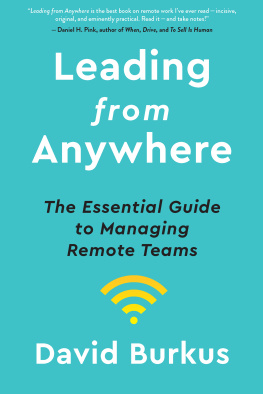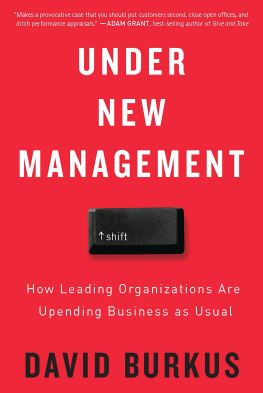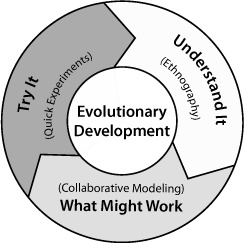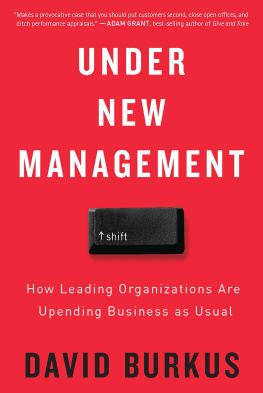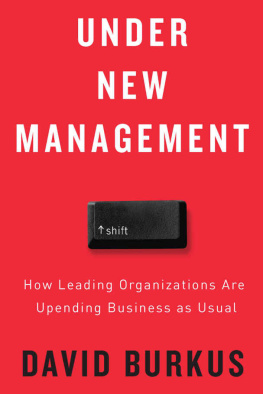David Burkus - Leading from Anywhere
Here you can read online David Burkus - Leading from Anywhere full text of the book (entire story) in english for free. Download pdf and epub, get meaning, cover and reviews about this ebook. year: 2021, publisher: HMH Books, genre: Business. Description of the work, (preface) as well as reviews are available. Best literature library LitArk.com created for fans of good reading and offers a wide selection of genres:
Romance novel
Science fiction
Adventure
Detective
Science
History
Home and family
Prose
Art
Politics
Computer
Non-fiction
Religion
Business
Children
Humor
Choose a favorite category and find really read worthwhile books. Enjoy immersion in the world of imagination, feel the emotions of the characters or learn something new for yourself, make an fascinating discovery.
- Book:Leading from Anywhere
- Author:
- Publisher:HMH Books
- Genre:
- Year:2021
- Rating:5 / 5
- Favourites:Add to favourites
- Your mark:
- 100
- 1
- 2
- 3
- 4
- 5
Leading from Anywhere: summary, description and annotation
We offer to read an annotation, description, summary or preface (depends on what the author of the book "Leading from Anywhere" wrote himself). If you haven't found the necessary information about the book — write in the comments, we will try to find it.
David Burkus: author's other books
Who wrote Leading from Anywhere? Find out the surname, the name of the author of the book and a list of all author's works by series.
Leading from Anywhere — read online for free the complete book (whole text) full work
Below is the text of the book, divided by pages. System saving the place of the last page read, allows you to conveniently read the book "Leading from Anywhere" online for free, without having to search again every time where you left off. Put a bookmark, and you can go to the page where you finished reading at any time.
Font size:
Interval:
Bookmark:
Copyright 2021 by David Burkus
All rights reserved
For information about permission to reproduce selections from this book, write to or to Permissions, Houghton Mifflin Harcourt Publishing Company, 3 Park Avenue, 19th Floor, New York, New York 10016.
hmhbooks.com
Library of Congress Cataloging-in-Publication Data is available.
Names: Burkus, David, 1983 author.
Title: Leading from anywhere : the essential guide to managing remote teams/ David Burkus.
Description: Boston : Houghton Mifflin Harcourt, 2021. | Includes bibliographical references and index.
Identifiers: LCCN 2020044142 (print) | LCCN 2020044143 (ebook) | ISBN 9780358533276 (hardcover) | ISBN 9780358573777 | ISBN 9780358573807 | ISBN 9780358533382 (ebook)
Subjects: LCSH: Virtual reality in management. | Virtual work teamsManagement. | Leadership.
Classification: LCC HD30.2122 .B87 2021 (print) | LCC HD30.2122 (ebook) | DDC 658.4/022dc23
LC record available at https://lccn.loc.gov/2020044142
LC ebook record available at https://lccn.loc.gov/2020044143
Cover design by Pete Garceau
Author photograph courtesy of Daniel Folkers
v1.1220
To everyone still working from a cubicle.
Freedom is coming.
W HEN HAYDEN BROWN assumed the role of CEO of Upwork on January 1, 2020, she probably never imagined her first year would go quite like it did.
Upwork, a billion-dollar company, was created when Elance and oDesk merged to become the worlds largest platform for finding and working with freelance talent. Prior to 2020, most of the companys employees already worked remotely from eight hundred cities around the world. The company had several traditional office locations for employees who werent ready for remote, but even the office receptionist was a virtual employee who managed multiple front desks from her home office. Under the leadership of Browns predecessor, Stephane Kasriel, the company that managed the worlds largest pool for remote talent had operated as remotely as it could.
Or so they thought.
When a novel coronavirus started spreading rapidly across the globe, Brown and her leadership team found themselves in the same position as many other senior leaders. They had to decide how to respond. They had to figure out how to keep the business operating while also ensuring the safety of all of their stakeholders. But unlike a lot of companies, they didnt decide to send everybody home for a short-term, work-from-home experiment. Instead of a short-term pivot, they saw it as time to commit.
They had done the research. They had been a supporting pillar in the remote-work movement for long enough, but just kept hanging on to their office space. It was time to finalize the inevitable transition to becoming fully remote.
Building on our 20 years of experience as a remote-work company, we are now permanently embracing a remote-first model. Going forward, working remotely will be the default for everyone, Brown posted on Twitter, ending her post with The #futureofwork is here.
This is a book about that future. Or, perhaps better stated, this is a book about the past, present, and future of remote teamsand how you can thrive in your role as a leader in that future.
Its difficult to trace the origins of remote teams. On some level, theyve always been a reality. The Roman Empire stretched across three continents, but Caesar had to settle for roads and messengers. At the height of its colonialism, it was said the sun never set on the British Empire, but Queen Victoria had to keep it all together using ships and trade routes. Even in the relatively short history of the United States, circuit riders coordinated to preach across the growing country and traveling salesmen went door-to-door even before the automobile to maximize revenue for their companies and themselves.
But when we talk about remote work and remote teams today, most of us are discussing the movement away from the traditional office. And if thats our frame of reference, then we should probably use 1973 as our official start date. That was the year Jack Nilles published The Telecommunications-Transportation Tradeoff. Nilles and his coauthors were convinced that the rising problem of traffic congestion wouldnt be solved by widening highways. Instead, they saw it as a communication problem that technology was rapidly solving. They argued that companies could help ease the traffic problem by shrinking the size of their headquarters and building an array of satellite offices scattered at the edges of their home citywhich isnt all that different from remote workers scattered around an array of local coffee shops today. There werent any personal computers at the time, and the coffee wasnt as good, but Nilles and company believed that mainframe computer technology and existing telephone lines were sufficient to coordinate work remotely. Nilles even coined a term for this: telework.
The advocates for telework only grew stronger as technology advanced and computers shrank in size. In 1989, Charles Handy argued that personal telephones signaled the beginning of the end for large offices, writing, Link it to a laptop computer and a portable fax, and a car or a train seat becomes an office. In 1993, fellow management thinker Peter Drucker declared, Commuting to the office is obsolete. But corporate leaders must not have gotten the fax. And if they did, giving up their corner office wasnt something they wanted to rush into. Instead of an office-less revolution, the percentage of remote workers increased slowly. It grew most quickly among tech firms, perhaps because of their familiarity with the very tools needed to more effectively collaborate from afar.
In the past decade, two big events shaped the debate about remote teams and whether working from home was actually just a form of barely working. The first occurred in February 2013, when newly appointed Yahoo! CEO Marissa Mayer sent a companywide memo declaring the end of remote work for the company. We need to be one Yahoo! the memo read. And that starts with physically being together. Many companies followed suit. Hewlett Packard, IBM, and even Best Buy (previously known for its Results-Only Work Environment) all called their remote teams back from home to the home office. In lieu of working remotely, many of these same tech companies increased their lavish spending on workplace perks designed to not so subtly encourage employees to focus more on their work and less on worrying about the outside world.
And so the remote-work revolutions pace slowed to a crawl. By 2018, only around 3 percent of American employees reported that they worked more than half of their hours remotely. The march toward remote work was still growing, but much more slowly than before.
Then, suddenly, it got an unexpected push. The response to the threat of the COVID-19 pandemic practically brought the world to its knees, but it brought movement toward remote work to an all-out sprint. At the time, moving everyone rapidly to remote teams was reactionary and likely seen as temporary. But having sampled the benefits of remote work, most people dont want to go back to the office any time soon.
A survey conducted by IBM during the height of the COVID-19 pandemic found that more than half of employees want remote work to be their primary method of working, and 75 percent said theyd like the option to continue working remotely at least some of the time. And many companies have responded in kind. Partly out of safety concerns and partly in response to what they discovered during their forced trial of remote work, many companies announced that they would give employees the ability to continue working remotely long after efforts to flatten the curve of COVID-19 cases was over. Citigroup, one of the worlds largest banks, told its people that most of them would be staying out of the office for nearly a year. Facebook CEO Mark Zuckerberg went even further, announcing that likely half of their 48,000 employees would shift to remote work permanently. (The Facebook announcement is particularly ironic, because during the height of the office perks trend, the company spent more than $1 billion and hired renowned architect Frank Gehry to create the largest open office floor plan in the world.) Like Hayden Brown, Shopify CEO Tobi Ltke announced that Canadas most valuable company would become a digital-by-default company. Theyd keep some of their office space for some operations, but the move to remote was permanent. Office centricity is over.
Font size:
Interval:
Bookmark:
Similar books «Leading from Anywhere»
Look at similar books to Leading from Anywhere. We have selected literature similar in name and meaning in the hope of providing readers with more options to find new, interesting, not yet read works.
Discussion, reviews of the book Leading from Anywhere and just readers' own opinions. Leave your comments, write what you think about the work, its meaning or the main characters. Specify what exactly you liked and what you didn't like, and why you think so.

